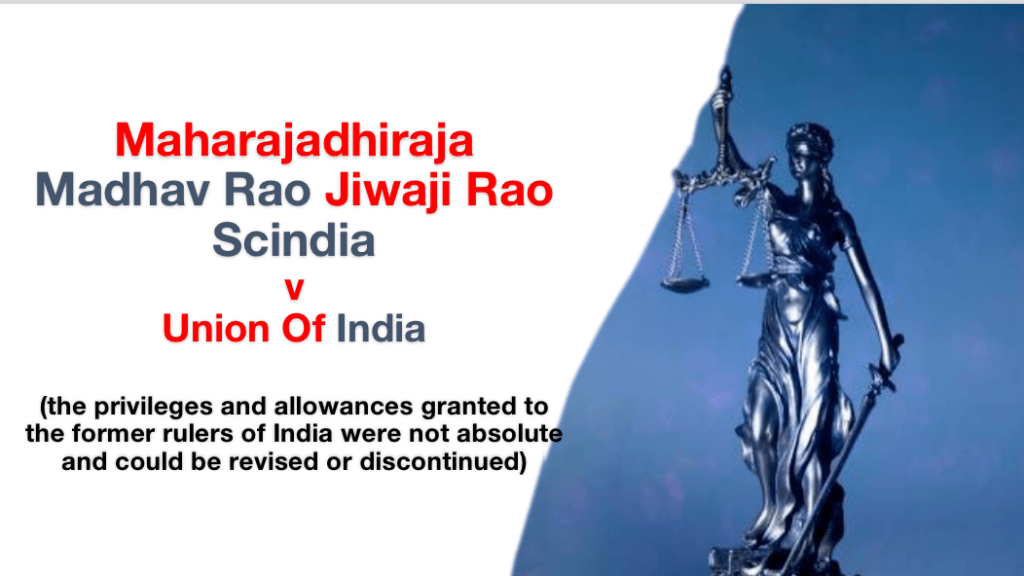
Case
Maharajadhiraja Madhav Rao Jiwaji Rao Scindia v Union Of India
Bench
The Maharajadhiraja Madhav Rao Jiwaji Rao Scindia v Union Of India landmark judgement was decided by a Constitution Bench of the Supreme Court of India. The bench consisted of the following judges:
- Justice K. N. Singh
- Justice Ranganath Mishra
- Justice M. N. Venkatachaliah
- Justice K. N. Saikia
- Justice K. Ramaswamy (author of the majority opinion)
- Justice S. C. Agrawal
- Justice M. H. Kania
- Justice V. Khalid
- Justice S. Ratnavel Pandian
- Justice A. M. Ahmadi (who delivered a concurring opinion)
- Justice M. M. Punchhi (who delivered a concurring opinion)
Parties
Petitioner -: Maharajadhiraja Madhav Rao Jiwaji Rao Scindia
Respondent -: Union of India
Citation
(1970) 1 SCC 85.
Introduction
Maharajadhiraja Madhav Rao Jiwaji Rao Scindia v Union Of India, which is commonly known as the Scindia Case, is a landmark judgement in Indian administrative law. It is a significant case because it clarified the distinction between property rights and social security, specifically with regard to the privileges and allowances of the former rulers of India. The Scindia Case was decided by a Constitution Bench of the Supreme Court of India on 11 December 1989.
Facts of the Case
Madhav Rao Scindia was the former ruler of Gwalior state in Madhya Pradesh. After Indian independence, the princely states were integrated into the Indian Union, and the rulers were granted certain privileges and allowances under the Constitution (26th Amendment) Act, 1971.
In 1975, the Indian government revised the rules governing the privileges and allowances of the former rulers, and Madhav Rao Scindia challenged the validity of these rules in court. He contended that the rules were discriminatory, arbitrary and violated his fundamental rights guaranteed by the Constitution.
Issues
At the core of the Scindia Case, there were two questions that were addressed by the Supreme Court.
- The first issue was whether the privileges and allowances of the former rulers of India could be considered “property” and therefore be protected under Article 19(1)(f) of the Indian Constitution, which guarantees the right to hold and dispose of property.
- The second issue was whether the rules governing the privileges and allowances of the former rulers of India violated the principles of equality and non-discrimination enshrined in the Constitution.
Judgement and Analysis
- The Supreme Court’s ruling in the Scindia Case provides answers to the two issues raised by the petitioner. Justice Ramaswamy delivered the majority opinion of the Court, while Justice Punchhi and Justice Ahmadi delivered concurring opinions.
- To decide the first issue, the Court examined whether the privileges and allowances granted to the former rulers were in the nature of property rights or a form of social security. The Court argued that social security rights were different from property rights, as they were not absolute and were subject to certain limitations that were necessary for public policy reasons.
- The Court concluded that the privileges and allowances granted to the former rulers were primarily social security measures, designed to ensure their continued participation in the democratic process. As such, these privileges and allowances were subject to reasonable restrictions, and could be revised or discontinued by the government from time to time.
- On the second issue, the Court held that the rules governing the privileges and allowances of the former rulers were not discriminatory or arbitrary, and did not violate any fundamental rights. The Court reiterated that the Constitution made a distinction between the rights of private citizens and those of the former rulers, and that the latter were subject to the doctrine of reasonable classification. The Court examined the provisions of the revised rules in detail and held that they were reasonable, and did not violate any constitutional rights.
- The Court also clarified the scope of judicial review In matters of policy decision-making. The Court emphasized that the revision of these rules was a matter of policy, and that the judiciary should not interfere in policy decisions unless they were arbitrary or capricious. The Court concluded that the revision of the rules was a reasonable policy decision, and dismissed Madhav Rao Scindia’s petition.
- The Scindia Case has been cited in several subsequent cases involving the revision of government policies that affect the rights of citizens. It has contributed to the development of administrative law in India by clarifying the distinction between social security rights and property rights, and by reinforcing the principle of reasonable classification.
Conclusion
Overall, the Scindia Case remains a landmark judgement in Indian administrative law. It has clarified the scope of judicial review in policy decision-making and laid down the principle that the privileges and allowances granted to the former rulers of India were not absolute and could be revised or discontinued by the government from time to time. This case also highlights how the principles of equality and non-discrimination enshrined in the Constitution can be reconciled with the government’s obligations to provide social security to certain sections of society. The Scindia Case has certainly contributed to the development of administrative law in India, and continues to be a reference point for certain disputes that emerge between the government and individuals.
written by Ananya Singh, Forth Year student at Integral University, Lucknow




0 Comments